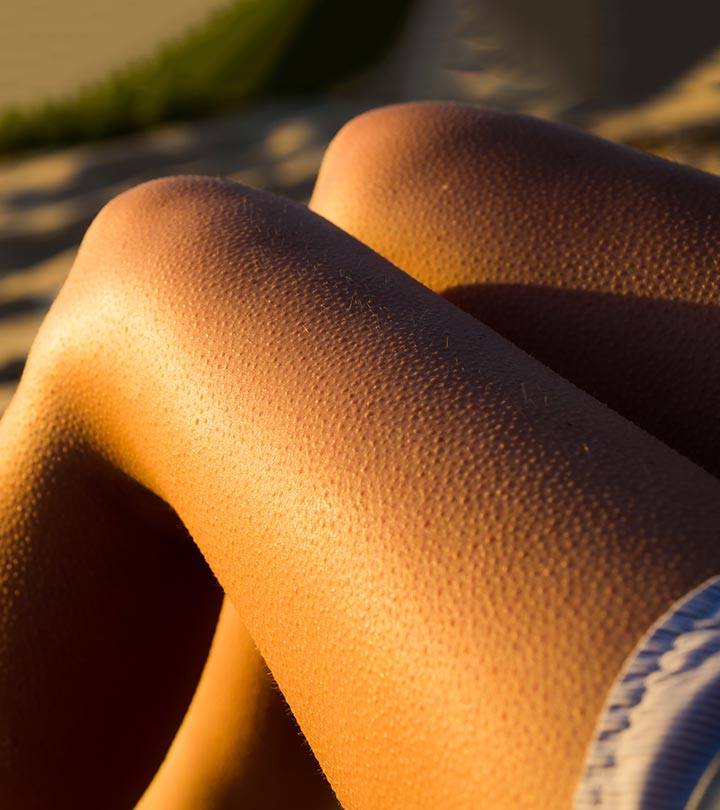It’s much easier than one may believe to get rid of strawberry legs, often known as those dark patches that give the appearance that your skin resembles the outside of a strawberry. However, you must first comprehend what these dots are and how they originated before you can even begin to consider remedies for getting skin that appears clearer and smoother. Therefore, even though it’s not thought to be dangerous, if you’re bothered by the presence of these black dots, there are a few techniques to stop them from appearing. You’ve come to the correct place if “How to get rid of strawberry legs” is the topic of your most recent search.
WHAT ARE STRAWBERRY LEGS

Keratosis pilaris (KP) or strawberry legs is a common skin disorder caused by an accumulation of keratin, a protein that clogs pores. Strawberry legs can be cured, but KP is incurable. Nevertheless, at-home treatments like hydrating and exfoliating your skin might lessen the appearance.
Clogged pores on the skin that resemble strawberry seeds are referred to as strawberry legs, thus the name. In contrast to the fruit, though, it’s something that women frequently want to get rid of. Strawberry legs are commonly characterized by increased pores and dark patches on the skin that correspond to the hair follicles.
WHAT CAUSE STRAWBERRY LEGS
SHAVING
Strawberry legs can occasionally result from shaving, especially when done incorrectly with old, dull blades or without shaving lotion.
In addition to causing strawberry legs, razor burns can result in folliculitis. Ingrown hairs can also occur after shaving.
These ingrown hairs can be the reason for strawberry legs in certain people. Those with thick body hair are more likely to experience this.
Occasionally, the irritation from shaving may cause the skin surrounding the follicle to darken, which accentuates the dark appearance.
CLOGGED PORES
Your legs’ skin has hundreds of pores, and just like any other pores, they can get blocked with dirt, dead skin cells, and bacteria.
Open comedones are the term for these blocked pores. The oil inside the blocked pores oxidizes and turns black when it comes into contact with air.
Your legs may be easier to see if you have dense body hair or wider pores on them from heredity.
FOLLICULITIS
When the hair follicle becomes inflamed and occasionally infected, it is known as folliculitis.
Shaving, waxing, and other hair removal techniques that expose the hair follicle to greater danger might cause this illness.
However, it may also happen if you’ve been in contact with microorganisms yeast fungus
Folliculitis can also result from using a hot tub when the chemicals and pH levels haven’t been correctly adjusted.
Usually beginning as tiny red pimples or blisters, folliculitis can progress into crusty lesions that are difficult to heal.
Folliculitis may occasionally be associated with ingrown hairs that are having difficulty penetrating the epidermis. This may also result in the appearance of darker skin that is linked to strawberry legs.
KERATOSIS PILARIS
Keratosis pilaris is a common and benign disorder that affects the skin of the upper arms and thighs.
The small, rough, and hard-to-the-touch lumps associated with keratosis pilaris may initially resemble tiny pimples, goosebumps, or “chicken skin.”
In reality, the lumps brought on by keratosis pilaris are microscopic collections of dead epithelial (skin) cells and the protein keratin. Despite the fact that moisturizers can help, they can be dry and irritating.
Seasonal in nature, keratosis pilaris usually manifests more commonly in the dry winter months.
On the other hand, frequent swimming may cause keratosis pilaris. The chemicals in swimming pools tend to dry out the skin. If you reside in an area with little humidity, this can also be the case.
OVERLY DRY SKIN
In addition to various disorders that mimic strawberry legs, dry skin can also cause or worsen the symptoms of strawberry legs.
But dryness doesn’t automatically lead to darker pores.
It is more likely that shaving will irritate your skin if it is really dry. You run the risk of getting folliculitis, razor burn, and the infamous “strawberry legs” look as a result.
Additionally, keratosis pilaris, folliculitis, open comedones, and razor burn become more noticeable to the unaided eye when an area is dry.
HOW TO TREAT STRAWBERRY LEGS

EXFOLIANTS
Exfoliants may be used to treat strawberry legs and use chemicals that minimize pores. Seek for products with salicylic or glycolic acid listed. These components aid in reducing inflammation, removing dead skin cells, and clearing clogged pores. After exfoliating your skin, think about using keratolytic, a chemical exfoliator that aids in removing dead skin cells. Use keratolytic as directed by a dermatologist or per the label. Excessive application of the product could cause skin irritation.
HUMIDIFIER
If the air in your house tends to dry out your skin, a humidifier can assist in maintaining moisture in the air. Hydrating your skin contributes to both the prevention and treatment of KP flares. To prevent the growth of mold and germs, clean and disinfect your humidifier on a regular basis.
LASER AND LIGHT THERAPY
If your KP is persistent and not improving with at-home treatments, you may want to look into laser and light therapy. For instance, studies have shown that intense pulsed light (IPL) therapy helps patients with KP have more equal skin tone, eliminates rough skin, and lessens redness.
MOISTURIZER
After shaving your legs, especially, it’s critical to moisturize your skin to prevent KP. Look for a moisturizer that contains urea or lactic acid. To seal in moisture, make sure you apply moisturizer to damp skin no later than five minutes after taking a bath or shower. If you have dry skin, reapply during the day as necessary.
Make use of a light shaving cream. To prevent causing irritation to your skin, go for an epilator or razor that has two blades. Apply a moisturizer containing ceramides or colloidal oatmeal afterward, as these components aid in protecting and calming your skin.
RETINOIDS
A derivative of vitamin A called retinoid helps hasten the turnover of skin cells. Retinoids hence enhance skin tone and stop keratin accumulation in your pores. Retinoids are available as topical creams or as oral capsules.
STEROID CREAM
Topical steroids can help treat KP by reducing inflammation. Consider consulting a dermatologist prior to using a steroid cream. According to a review that was published in 2021, using some steroid creams could lead to an increase in sebaceous (oil) glands on the face. The researchers observed that having more oil glands could lead to more hair follicles and a worsening of KP.
FINAL TAKEAWAY
While maintaining bump-free skin on our faces is a major concern for many of us, getting the same silky-smooth results from the neck down can also be high on our list of priorities. The reason why skin issues like body acne, keratosis pilaris (KP), and “strawberry legs” are so prevalent is that so many people have bothersome lumps all over their bodies.
Small dark or pink pots that run up and down the legs are a distinctive feature of strawberry legs. Clogged pores may be the cause of strawberry legs, despite the misconception held by some that the spots are hair follicles, debris, or even blackheads. If you are desperate to get rid of strawberry legs, check out our recommended treatments.







